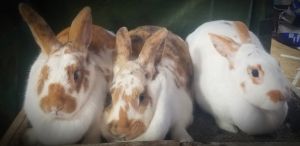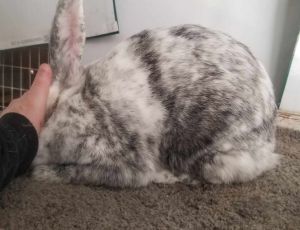Partiquin
== Partiquin "Senita" Project ==
The official Working Breed name will be Senita Partiquin Composites were bred by Mary-Margaret Conley in 2018. Stephanie Hughes joined the project in 2020, and Elizabeth Yardley Kangas came on board in 2023. Madison Simmons of Colorado Spring CO joined Fall of 2024 along with A few others who are helping with the project.
The Partiquin Composite " Senita " was started by crossing between a Japanese Harlequin-colored non-pedigreed Doe and a New Zealand red, then crossed back to a New Zealand broken Black.
Non-physical Traits
non-physical traits that are selected are inquisitive, friendly, happy rabbits, with great mothering ability,
physical traits
Senitas are known for their heat and cold tolerance. They have been thriving and doing binkies in temperatures ranging from 0 degrees to 100 degrees. They tend to have slightly larger ears and a slightly longer shoulder and midsection than New Zealands, typically 3-4 inches in proportion. A shorter shoulder and longer midsection are preferred, but not so long as to be mandolin-shaped. When viewed from above, they should be egg-shaped. Most Partiquins have larger litters, like Harlequins.
As of 2023, the Senita rabbit breed is still New Zealand-sized, which is between 9 and 12 pounds. However, Mary Conley has successfully bred rabbits that weigh up to 12 pounds and is slowly working on breeding them to weigh up to 16 pounds. Her goal is to increase their weight without sacrificing their commercial type or color.
Mary's litters are currently hitting 2 pounds, 10 ounces at 5 weeks. Her goal is to increase that to 4-5 pounds by 8 weeks. She's hoping to move those goals up as the litter size increases. To that end, she has incorporated a close-coupled Flemish cross doe and is seeking a shorter shoulder giant chin or nicely typed extra large line to incorporate.
Senita working Standard
A large rabbit of COMMERCIAL TYPE with Medium bone.
Weights
Jr Min weight 5lbs Jr Max Weight 10lbs
Int Min Weight 10.5lbs Int Max Weight 11.5lbs
Sr Min Weight 12lbs Sr Max Weight no max
Body
Body to be well muscled with excellent fullness front to back. Presenting an overall sense of balance. Full smooth loin. A gradual rise begining at the nape of the neck peaking over the center of the hips. A slight curve over the rear of the hindquarters to the table. Not undercut. Partiquins should have equal depth and width, with a gradual egg 🥚 shape when viewed from above.
Fault:
- Chopped Hindquarters
- Undercut hindquarters
- Pinched hindquarters
- Weak or low Shoulders
- Overly long shoulders( mandolin)
- Overly short shoulders(compact)
- Peak too far forward.
Coat
coat type is Roll-back coat. The Senita rabbit should have a thick coat that is approximately 1.5 inches long. The coat should be full, dense, and luxurious to demonstrate the dual purpose of this breed.
Fault:
Open or Dirty Coat
Varieties
- Japanese Brindled
- Magpie Brindle
- Broken/shotgun Magpie
- Tricolor
These varieties are shown in Rollback coats. Mismatched nail colors are allowed. , body type is to be weighed heavier in all varieties, over pattern clarity.
Even Brindled marking uniform over the whole body Color should be rich high rufus and have depth regardless of coat type.
FAULT
Less than 40% or more then 60% color coverage, on Tricolor
Less than 40% or more then 80% color coverage Broken Magpie
Solid patches Larger then 2-3.5 sq inches of any one color and large bands of Color Japanese Brindle color variety
Solid patches Larger then 2-3.5 sq inches of any one color and large bands of Color on Magpie Brindle varieties
DQ's
Close coupled Body. Looking more like a compact type than a commercial type.
Mandolin resembling a Flemish Giant
Less than 20% or more then 80% color coverage, on Tricolor
Less than 20% or more then 90% color coverage shotgun Magpie
Large clean solid patches of color larger then 4sq inches to mimic the harlequin breed.
Large clean solid patches of color larger then 4sq inches to mimic Magpie Banding
Blue Eyes,
Dutch or Booted Patterning when the white does not extend past the elbow
English Spot/Rhinelander pattern
PartiQuin / Senita Genetics
Ideally you want rabbits with the following base genetics
- AA--C---ejej-- ww +++ Agouti Based , full color, homozygous Japanese gene, Wide band , with high rufus
- aa--C---ejej-- ww +++ Self Based , full color, homozygous Japanese gene, Wide band , with high rufus
- AA--chdchd---ejej-- ww +++ Agouti Based , homozygous Chinchilla , homozygous Japanese gene, Wide band , with high rufus
- aa--chdchd---ejej-- ww +++ Self Based , homozygous Chinchilla, homozygous Japanese gene, Wide band , with high rufus
you want to avoid breeding in
- Vienna(V)
- White Ear(We)
- Lutino (P)
- Dutch(Duw or Dud)
- Himalayan Californian (ch)
- Chinchilla Light Shaded (chl)
- Silver (Si)
- Steel (Es)
- Tan (at)
The coat of the Partiquin should be thick, full, dense, and luxurious. It should be approximately 1.5 inches long. This breed is a dual-purpose rabbit, and its coat should demonstrate this.

